The National Day of Remembrance of the victims of racist and anti-Semitic persecutions by the French State and of tribute to the righteous of France

The national day of remembrance of the victims of racist and anti-Semitic persecutions by the French State and of tribute to the 'righteous' of France was founded in response to the wish expressed by the Jewish community, as well as a number of French personalities, to have officially recognised the Vichy regime's responsibility in the persecutions and crimes that took place against the Jews during the Second World War (1939-45).
From 1993 to 2000, two texts set forth the terms of this national commemoration.
From 1993 to 2000: The French Republic adopted two texts to recognise the racist and anti-Semitic persecutions committed by the ”government of the French State” (1940-1944) and pay tribute to the ”righteous” of France
In 1993: Sunday 16 July, or the following Sunday, was declared the national day of remembrance.
Decree no. 93-150 of 3 February 1993, signed by the President of the Republic François Mitterrand, established ”a national day of remembrance of the racist and anti-Semitic persecutions committed under the authority of the so-called ”government of the French State (1940-1944)”. The 16th July, the anniversary of the roundup at the Vélodrome d'Hiver (16th July 1942), was chosen as the day of commemoration if it fell on a Sunday, otherwise the following Sunday would be the designated day of remembrance. This tragic episode of the Occupation was previously remembered through ceremonies organised by the Jewish community.
The decree also stipulated the erection of monuments and steles in Paris, at the government's expense, at the site of the internment camp in Izieu and in the capital town of each Department. A monument was erected near to the former Vélodrome d'Hiver and steles were put up at Camp de Gurs (Pyrénées-Atlantiques) and the Maison d'Izieu (Ain), the memorial to Jewish children murdered during the Holocaust. On 17 July 1994 a monument was inaugurated in Paris, in the vicinity of the former Vélodrome d'Hiver, near the Pont de Bir Hakeim, and appointed as the site of the official ceremony. Outside of Paris, this takes place, under the authority of the Prefect, at the plaques erected in the capital towns of each French Department. On 16th July 1995, in a speech given at this commemoration, the President of the Republic, Jacques Chirac, recognised that ”the criminal folly of the occupiers was seconded by the French” and that ”France, on that day, committed the irreparable”. He added that the roundup at the Vélodrome d'Hiver was ”the starting point of a vast resistance movement” in which many French families took part, the ”righteous” who saved countless Jews.
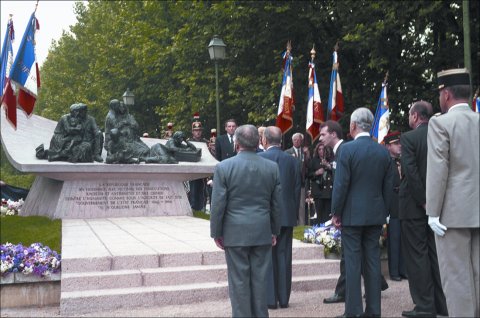
The monument erected near the Vélodrome d'Hiver, in Paris. Source: MINDEFSGA/DMPA - Jacques Robert
In 2000: the act added a tribute to the ”righteous” of France
Act no. 2000-644 dated 10th July 2000 adopted and amended the decree of 1993 to importantly add a tribute to the righteous of France. This legal commemoration became an occasion for the nation to show its recognition of all those ”who took in, protected or defended, risking their own life and asking for nothing in return, one or more people threatened by genocide”.
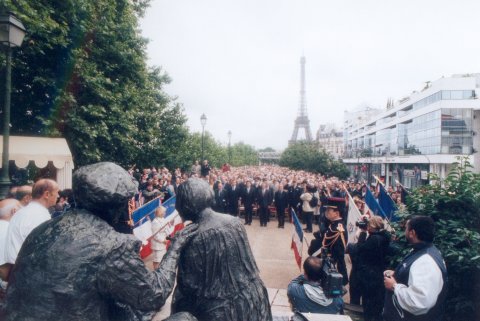
The ceremony of the 16th July 2000. Source: MINDEF/SGA/DMPA
The Vel d'Hiv roundup (July 1942): The symbol of the racist and anti-Semitic policy of the Vichy regime
The national day of remembrance links the recognition of the French government's responsibility in the crimes committed during the Occupation with the 16th of July to the anniversary of the roundup at the Vélodrome d'Hiver.
1942 : The Vel d'Hiv roundup
On the 16th and 17th July 1942, nearly 13,000 people - men, women and children - were arrested by French gendarmes and police officers under the orders of Jean Leguay, second-in-command to René Bousquet, secretary-general of the Ministry of the Interior for the Vichy police. The operation was conducted based on lists compiled by the police headquarters in advance. Some 7,500 people, including 4,000 children, were assembled at the Vélodrome d'Hiver, in the worst conditions since nothing was provided, before being transferred to the internment camp in Le Loiret; the others were transported directly to Drancy and deported to the east over the summer. This roundup wasn't the first, but due to its scale and the involvement of the French government, it was the most significant. It came on the back of the policy implemented by the government in power.
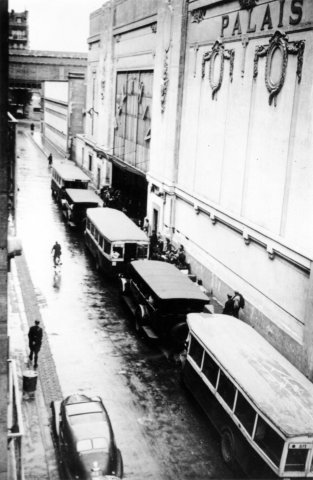
16th July 1942: Outside the Vel' d'Hiv', the buses used to transport the Jews rounded up at each local assembly centre to the Vélodrome d'Hiver - C BHVP / Fonds France Soir (Bibliothèque historique de la Ville de Paris)
From 1940 to 1944: The Vichy Regime's racist and anti-Semitic policy
On 10th July 1940, the members of Parliament assembled at Vichy voted, by 569 votes to 80, to grant full powers to Marshal Pétain. The following day, this promulgated the first three constitutional acts that founded the French government. The government immediately engaged in a racist, xenophobic and anti-Semitic policy, promulgating laws that excluded a part of the French population from the national community due to its ”race”. Its aim was to limit the role and economic, political and intellectual influence of ”undesirables”, in particular Jews, and to appropriate their property. This policy was the direct consequence of the ”national revolution” sought by Pétain, who claimed that the defeat fell on the responsibility of the preceding governments and the parliamentary regime.
The first exclusionary measures were taken by the Vichy government in July 1940. On 17th July, a law banned persons born to a non-French father, apart from a few exceptions, of entering the civil service. On 22nd July a law was introduced concerning the review of naturalisations that took place under the regime established in 1927 by the new code of nationality. Following this revision, 15,154 persons had their French nationality withdrawn. Moreover, those considered a danger to national security were put under house arrest or interned in detention camps. Gypsies, a roaming population undeterred by border crossings, were interned in over 30 camps located in both the non-occupied and occupied zones.
The members of the Jewish community were soon the next direct victims of these discriminatory measures. Two laws promulgated two Jewish statutes, the first on 3rd October 1940 and the next almost a year later on 2nd June 1941. By adopting these positions, the Vichy government acted on its own behalf, anticipating German orders. The compulsory census was carried out on the Jewish population and Jews were forbidden from holding certain positions, posts and professions. They were thus excluded from the civil service, the magistracy, the army, the press, industry and professional occupations. The statute was extended by the law dated 4th October 1940 that authorised the internment or house arrest of Jewish foreigners. On 29th March 1941, a general commission for Jewish affairs, established by the French government on the behest of the German authorities, was tasked with controlling the application of the Jewish statute and anti-Jewish laws and producing anti-Jewish propaganda. Its authority was extended to cover both zones.
The French government opened or extended to the Jewish population internment camps in the south, such as the Camp de Gurs where thousands of foreigners - the majority German (53.6%), but also Polish (12.8 %), Spanish (10.9%), Austrian (9.8%), Russian, Belgian, Dutch, and Romanian - were assembled during the war, or those in Le Vernet, L'Ariège, and Les Milles, in Bouches-du-Rhône.
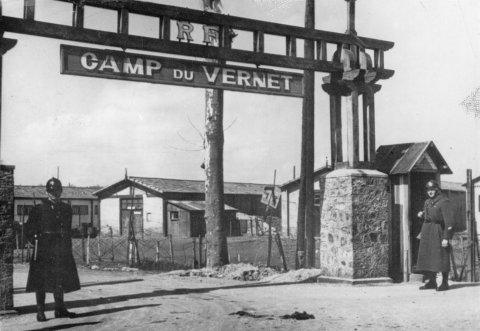
Camp du Vernet. Source: DR
From 1941 onwards, the French police took part in the first roundups and the internments that followed in the north of France. The first three took place in Paris. On 14th May 1941, 3,710 foreign or stateless Jews are interned in the camps in Pithiviers and Beaune-la-Rolande; on 20th August, some 3,477 Jewish or stateless people were arrested and transported to the camp in Drancy. At the end of the year, on 12th December, 1,000 people, including 700 French Jews, were interned at the camp in Compiègne.
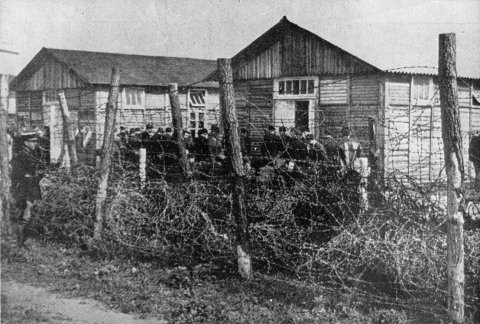
Camp de Pithiviers, in le Loiret. Source: DR
With the implementation of the final solution by the Nazis, the number of persecutions and roundups increased, affecting the entire Jewish community, French and foreigners, men, women and children.
The first Jews were deported from France to Auschwitz on 27th March 1942. By organising their census, arrest and internment and agreeing to deliver them to the Nazis, the French government was complicit in their extermination.
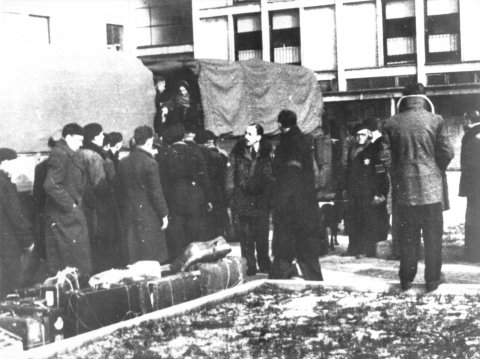
A convoy arriving at the camp in Drancy in Greater Paris. Source: DR
Of the some 300,000 Jews living in France, 75,000 were deported during the Second World War. The numbers of deportations continued to rise throughout the final months of the Occupation. On 6th April 1944, 44 Jewish children were arrested in Izieu with their supervisors. The last major roundup took place between 21st and 25th July 1944 and affected 250 children sheltered in the houses of the UGIF (the General Union of the Israelites of France). The final deportees left for the camp in Drancy on 17th August 1944, a week before Paris was liberated.
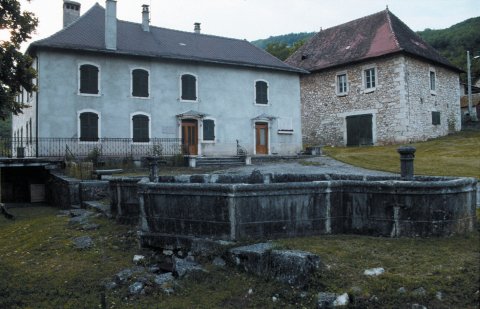
Maison d'Izieu, in Ain. Source: MINDEF/SGA/DMPA
Resistance by the ”righteous”
Breaching Vichy regulations and German orders by hiding people wanted by the police were extremely risky acts. However, during the war, French citizens, throughout the country, of all social categories and denominations, individually or collectively, shielded men, women and children being sought by the French police and the Germans. The Marcel network, for instance, saved 527 children, and the Protestant residents of the village of Chambon-sur-Lignon also hid a many children. Through their acts, they demonstrated that the republican values of liberty, equality and fraternity were still alive and well. Many individuals took in children, gave moral and material aid to families who found themselves left with nothing, obtained fake papers, notified them of roundups and refused to give their name to the authorities. It is impossible to quantify the number of the ”righteous” in France who, for the duration of the Occupation and the sake of humanity, hid and thus saved thousands of people from death. The nation decided therefore to recognise the actions of these righteous people and to honour these brave men and women during this national day of remembrance.
Mémoire et Citoyenneté collection, no.18, MINDEF/SGA/DMPA

